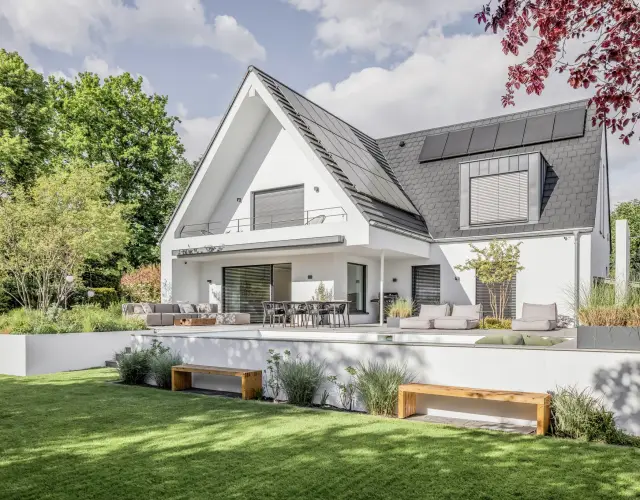
A new lease of life When architects make their dream house a reality
Seeing the potential in an old building or location is one of an architect’s special skills. When two architects came across a residential building in need of renovation, they found the house of their dreams and didn’t think twice when offered the chance to buy it along with its large plot of land.
Built in 1976, the angular single-storey house wraps around the south-facing patio located in front of the living space. The house has a full-length cellar, and before the renovation the attic was used solely for storage. The property’s construction and compartmentalised layout were far from suited to the expectations and requirements of a modern family.
With their vision in mind, the architects began by gutting the building entirely. The external walls were upgraded with an exterior insulation and finish system and a white plastered facade. The property developers removed the interior walls and replaced them with steel beams where structurally necessary. This created a generous, open living space with a dining area and kitchen. Two new openings were cut into the ceiling above the ground floor, creating an open gallery that allows the children’s rooms on the top floor to be seen and heard.
Lots of space in the new roof
Building regulations did not allow for the original plan of a continuous dormer above the entire side of the house, and so the architects sought other ways to better use the attic space. In the end, they removed the roof completely and replaced it with a new pitched roof with a higher angle. A high dormer on the street side now accentuates the entrance and stairway. In the northern arm, the architects created individual dormers with anthracite zinc cladding that harmonises with the black concrete roof tiles. Even the black photovoltaic panels on the roof surfaces (which supply electricity to the heat pump and house) blend into the background.
The new upper floor contains the family’s bedrooms, the children’s room, a dressing room and three bathrooms. The parents’ bedroom in the gable opens up onto a south-facing recessed balcony that appears to float above the patio. The cellar contains the utility rooms, guestroom and a wellness space with a sauna. In total, the new house has around 320 square metres of living space.
Even the windows are minimalist
To bring more daylight into the living rooms, the architects got rid of the old, small windows and had large, floor-to-ceiling openings cut into the walls. These were sealed with anthracite-coloured aluminium windows recessed deep into the wall on the same level as the insulation so that the frame profiles are barely noticeable from outside. The interior spaces are now flooded with light, even on the ground floor.
External venetian blinds from Warema protect the building from excessive heat and sunlight. There were physical reasons for this, and they also enhanced the design: Because the external venetian blinds were built into the same level as the insulation, they are invisible when raised, enhancing the overall look of the house. In addition to the excellent quality of the blinds, the architects particularly liked that the slats were available in a colour that matches the window profiles. As the property developer explains, when lowered – and with the help of the flexibly controllable slat positioning – the blinds create “a stunning interplay of light and shadow” inside the building. She adds that “this works particularly well with large window spaces such as ours. External venetian blinds offer so much added value. They protect against the sun and heat, but there’s still plenty of daylight in the room. You can look outside or enjoy your privacy, whatever you desire”.
For her, the pièce de résistance is the practical app that can be used from anywhere to operate the blinds and adjust them to the weather, including customisable time profiles for automated opening and closing. To make this happen, the Warema products were easily integrated into the existing smart home system, including the only roller shutters in the building; the architects installed these on the bedroom window so that all light can be shut out.
South-facing patio with pool
The architects, who love to spend time outdoors, concluded this one-year modernisation project with their absolute highlight: the south-facing patio with a pool. Shaded by a 5 x 7 metre Warema K70 Terrea cassette awning, this is their favourite part of the house. The awning was also fitted with a valance roller blind to block out the low-lying sun. The warm grey tone of the awning fabric fits in wonderfully with the modern ambience, as does the elegantly understated awning shape. “I wanted a shading solution that can be completely retracted and doesn’t disrupt the design of the house. For this reason, I felt it was very important to choose the right awning box shape. I was particularly drawn to the minimalist design of the cubic Warema Terrea K70 cassette awning. Also, the fabric and frame are well-protected against the wind and weather all year round.” The awning can be easily mounted on an exterior insulation and finish system – as was the case here – provided the size of the special console matches the mounting substructure and it is fitted in the right spot. It is important that an electricity supply is available to the awning connection. The property developers laid the cables for this during the renovation so that no further work was required on the facade.
Construction details
- Project: Renovation of a detached house with pool (built 1976)
- Architecture: Thiedmann Architekten und Partner, Hannover
- Total living space: approx. 320 square metres
- Completed: 2020
-
Products:
- WAREMA E 80 A6 S external venetian blind window system
- WAREMA V6 A37 front-mounted roller shutters
- WAREMA Terrea K70 cassette awning with valance roller blind,fabric: acrylic, design 4009, aluminium parts: DB 703, anthracite iron mica effect, fine texture
- WAREMA radio remote control with WMS WebControl pro
Note on image usage:
The use of the unchanged images is only permitted in the context of the respective press release and exclusively for editorial reporting on WAREMA products, not for advertising purposes. Please use "Copyright WAREMA" as the correct acknowledgment of the source. Please send a digital specimen copy.
Built in 1976, the completely renovated detached house now features clean lines, 320 square metres of living space flooded with light, and a south-facing patio with a pool.
A new pitched roof with dormers allows for better use of the roof space. The high dormer, also shaded by external venetian blinds, accentuates the entrance and ensures the right amount of daylight at all times.
The flexibly controllable slats conjure up a “a stunning interplay of light and shadow” inside the house with the perfect amount of daylight at all times.
Interior walls were removed to create a large dining area. External venetian blinds don’t just protect against sun and heat – they let daylight into the room, allow the occupants to look outside, and ensure privacy whenever desired.
The property developers were impressed by Warema’s products not just because of their durability and aesthetics, but also their excellent quality. “The slats don’t rattle – even when it’s windy outside, inside you don’t hear a thing”.
External venetian blinds from Warema protect the rooms behind the floor-to-ceiling windows from sun and excessive heat. Their colour matches the window profiles and because they are installed at the same level as the insulation, they are invisible when raised.
The cubic 5 x 7 metre Warema Terrea K70 cassette awning creates a pleasant shade on the south-facing patio. The awning is fitted with a valance roller blind to block out the low-lying sun.
Clearly a favourite spot: The architect appreciates the clear, cubic form of the awning, which blends harmoniously with the architectural concept.
Operated via an app, the awning can be controlled from anywhere using the Warema radio remote control with WMS WebControl pro. It was easy to integrate all the Warema products into the existing smart home system, and they can be opened and closed based on individually programmed time profiles or according to the weather.
Before its renovation, the one-storey house was a perfect example of the 1970s style.
Compartmentalised rooms and underused roof space – the house was far from suited to modern living requirements.
Share this page:
Your direct contact to us







